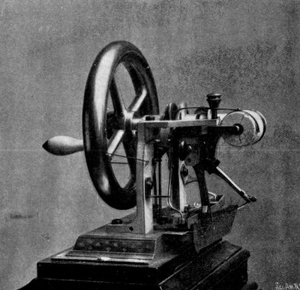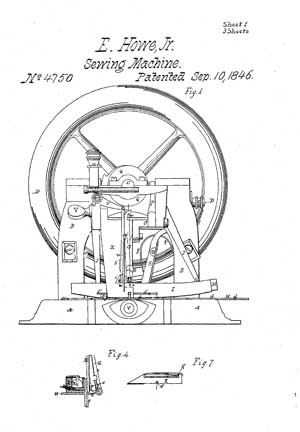 People attempted for decades to design a properly functioning sewing machine. There were many machines designed and patented which simply did not work. Then in 1830, Barthelemy Thimonnier, a French tailor, developed a successful model. This machine caused fear and outrage among tailors in France. Afraid that they would lose their livelihoods to this invention, a group of tailors destroyed the plant where Thimonnier was producing his sewing machine.
People attempted for decades to design a properly functioning sewing machine. There were many machines designed and patented which simply did not work. Then in 1830, Barthelemy Thimonnier, a French tailor, developed a successful model. This machine caused fear and outrage among tailors in France. Afraid that they would lose their livelihoods to this invention, a group of tailors destroyed the plant where Thimonnier was producing his sewing machine.
Walter Hunt was the first American to build a working sewing machine. He did not patent his device though. He believed the invention would cause tailors and seamstresses to lose their jobs.
Elias Howe first heard of sewing machines when working for Ari Davis. Here he fixed nautical equipment and many versions of sewing machines which were constantly in need of repair. These faulty machines inspired him to begin working on a machine that would actually fill the needs of seamstresses. Watching his wife work on the sewing she did to earn extra money for the family, he realized that he could never duplicate the motions of hand sewing. Instead, he began to work on a machine that would use thread supplied from two different sources.
After five years of working on the task, Howe perfected his invention and the first Automatic Sewing Machine was invented. Elias Howe’s machine created a lockstitch. The machine had a needle with an eye at the point. The needle was pushed through the cloth and created a loop on the other side. The second thread was slipped through the loop which created the stitch. The first US patent for a sewing machine was issued to Elias Howe on September 10, 1846. He received US patent 4,750 for an Improvement in Sewing-Machines.
 His new invention was not an instant success. During a demonstration of his new product in 1845, the machine out-sewed five seamstresses. Unfortunately, the $300 price tag deterred people from purchasing the machine. When he was unable to sell his machine in the United States, Howe went to England hoping for success. In England, Howe found a buyer for his sewing machine. William Thomas paid £250 for a machine that Howe never produced. He then bought the rights to Howes machine and paid him £3 a week to modify the machine for his corset and umbrella business. Once Howe had modify the machine, Thomas fired Howe.
His new invention was not an instant success. During a demonstration of his new product in 1845, the machine out-sewed five seamstresses. Unfortunately, the $300 price tag deterred people from purchasing the machine. When he was unable to sell his machine in the United States, Howe went to England hoping for success. In England, Howe found a buyer for his sewing machine. William Thomas paid £250 for a machine that Howe never produced. He then bought the rights to Howes machine and paid him £3 a week to modify the machine for his corset and umbrella business. Once Howe had modify the machine, Thomas fired Howe.
Thomas was never successful in producing the sewing machine. Still, when other machines were produced in England using Howe’s patents, Thomas profited from them with patent and license fees and royalties. His initial investment netted him over one million pounds. Howe, on the other hand, returned to America broke and still unsuccessful with his new machine.
On his return to America in 1849, Howe discovered that the sewing machine industry in the United States was prospering. Many inventors had infringed on his patent rights and were creating sewing machines of their own. The most successful of these companies was owned by Isaac Merritt Singer. He had built the first sewing machine in which the needle moved up and down rather than side-to-side. His machine was also powered by a foot pedal. Still the machine used the same lockstitch which Howe had patented.
Frustrated by watching other people succeed with his ideas, Howe sued Singer for patent infringement using funds from a mortgage that was taken out on his father’s farm. In 1854, eight years after patenting his sewing machine, Howe was victorious in defending his rights to the lockstitch. He won his patent lawsuit against Singer. All companies that were using his invention were now forced to pay him royalties.
The end of the court case saw Howe finally seeing some monetary rewards for his invention. Singer and other patent infringers were forced to pay him $15,000 in back payments. Every sewing machine sold in the United States which utilized Howe’s patent earned Howe five dollars and for every machine sold abroad he earned one dollar. By his death in 1867, Howe was collecting more than $4,000 a week. Between 1854 and 1867, he received more that 2 million dollars in total royalties.
Howe’s invention changed the sewing machine industry. The mass production of clothing was now possible. By 1905, the electrically-powered sewing machine was in wide use across the United States. Today, the lockstitch is still employed in many sewing machines despite other great advancements including computers that control the machines.
